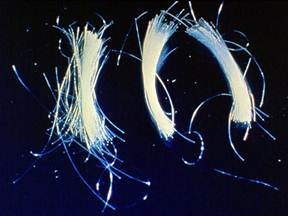

Webmaster: Stansfeld, LLC. |
|
|

JUNE 2012 MEETING
Wednesday, June 13, 2012 (1.0 PDH)
TECHNICAL PROGRAM: Steel and Macro Fiber Reinforced Concrete Technology
Speaker: Patrick Greer, Territory Manager for Propex Concrete Solutions (formerly S I Concrete Systems)
PRESENTATION SUMMARY
 To an audience of about 65, Patrick Greer with Propex discussed fiber reinforced concrete. The discussion focused on both steel and synthetic fibers with an emphasis on synthetic fibers. Mr. Greer noted that fiber reinforced concrete is now a global product. The design and specifications for fiber reinforced concrete are supported by ACI 360R-10 and approved for use by the Texas Department of Transportation. Testing of fiber reinforced concrete is defined in a number of documents including ACI Committees A8020, 544 and 506, and ASTM C1116, C1399, C1550, C1579 etc. Propex provides design and analysis support with a proprietary Concrete Systems Fibers Design Analysis software program.
To an audience of about 65, Patrick Greer with Propex discussed fiber reinforced concrete. The discussion focused on both steel and synthetic fibers with an emphasis on synthetic fibers. Mr. Greer noted that fiber reinforced concrete is now a global product. The design and specifications for fiber reinforced concrete are supported by ACI 360R-10 and approved for use by the Texas Department of Transportation. Testing of fiber reinforced concrete is defined in a number of documents including ACI Committees A8020, 544 and 506, and ASTM C1116, C1399, C1550, C1579 etc. Propex provides design and analysis support with a proprietary Concrete Systems Fibers Design Analysis software program.
A handful of the markets and uses for fiber reinforced concrete are:
- Residential and Slab on Ground Foundations
- Composite Metal Decks
- Industrial Flooring
- Transportation
- Walls
- Precast Concrete
- Shotcrete and Underground Structure
According to Mr. Greer, fiber reinforced concretes typically use synthetic fibers for early age performance to control cracking and finishes, steel fibers and macro-synthetic fibers for long term performance, and engineered blends of synthetic and steel fibers for a combination of performance traits. The different types of fibers are defined as micro-synthetic polypropylene (both monofilament and fibrillated), macro-synthetic, and steel. Due to the different properties of the different fibers the concrete mix may be tailored specifically for the intended use or final product required. Mr. Greer noted that Fibermesh has been used in many projects including thousands of successful residential slabs since 1982, as a topping over distressed asphalt pavement on highway projects, pavements, heavy commercial and industrial slabs, and fire protection among others. Factors for fiber selection include:
- finishability,
- crack control both plastic and settlement,
- topping thickness including ultrathin,
- impact resistance,
- shatter resistance,
- abrasion resistance,
- anti-spalling properties (used mostly for bridges and tunnels for fire protection to inhibit explosive spalling)
Polypropylene microsynthetics are considered the most tested and proven fiber type for concrete applications. The benefits of microsynthetic fibers listed by Mr. Greer are
- Inhibits early age shrinkage cracks
- Reduces settlement cracks
- Increases impact resistance
- Increases shatter resistance
- Reduces water migration
- Rreduces explosive spalling during fires
- Increases abrasion resistance
- Reduces rate of corrosion
- Increases rebar bond to concrete
- Has a measureable residual strength
- Reduces rebar placement issues
Steel fiber reinforcing provides similar benefits. Some of the benefits listed by Mr. Greer are
- Crack width control
- Ductility
- Fatigue resistance
- Impact resistance
- Flexural toughness
- Continuous crack restraint in x, y, and z directions
- Uniform reinforcement
- An alternative to rebar in slab on grade applications.
- Applicable for superflat floors
Engineered or blended fiber reinforced concrete can combine the best of both synthetic and steel reinforcing. In conclusion, engineers and design-build contractors can now enhance concrete designs that give:
- Increased post crack ductility
- Joint stability
- Crack containment & control with positive positioning of reinforcement
- Shear capacity
- Fatigue & impact resistance
To download a copy of the slide presented by Mr. Greer click here
For additional information contact Propex, 2482 Elgarose Rd., Roseburg, OR 97471, Tel. No. 541-391-4380, www.fibermesh.com
|



